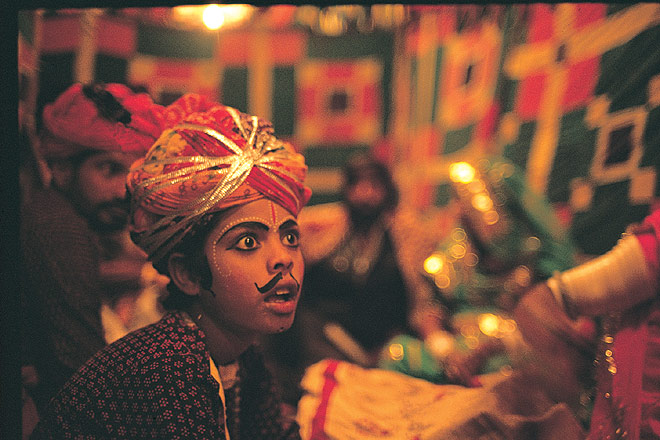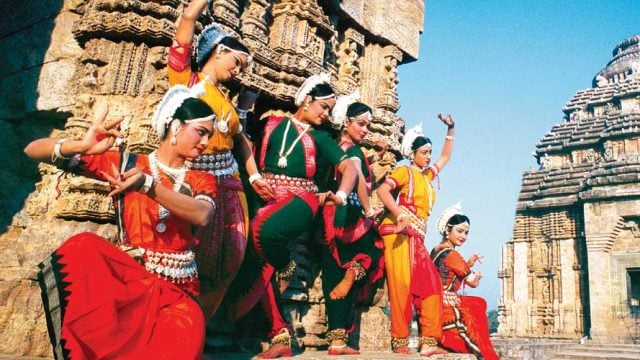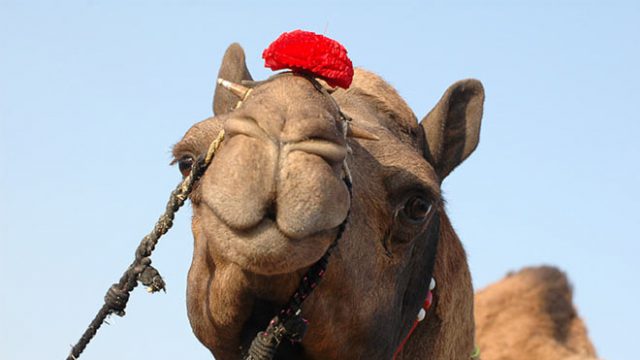After sordid Delhi, a murky night negotiating the desert on narrow-gauge brings me to Ajmer, railhead to
We leave Ajmer behind, slip through the fork in Nag Pahar, the serpentine hill separating Ajmer from Pushkar, and slide into this desi Lourdes. On the town’s western fringes, the annual cattle fair is coming together. It’s early days yet—the fair will open in about a week—but the camels are already here because of the drought.
This may well be the best time to be in Pushkar. The cattle fair is just swinging into gear and tariffs haven’t hit the sky (they go ten-fold and more during fair time) This is also when the actual commerce of the fair takes place, the touristy gimmicks (which include camel races and a tug-of-war between locals and phirangs) left for later.
The rose farms slip by as I head away past the mela ground towards bed and board and a gracious host. A hearty repast later I’m ready to hit the trail.
Pushkar hangs by a drop of lake in the middle of the desert, which sprung up when Brahma threw a lotus petal here. The only Brahma temple of any significance in the country is located here. And all the action is concentrated in Sadar Bazaar, which snakes along the lake’s edge.
There are basically two kinds of visitors. Hordes of devout Indians and the very last of flower power. No space yet for the India-born confused desi. Of course, Pushkar has long been on the hippie circuit. Simple necessities like chillums and hemp are freely available in this strictly vegetarian and alcohol-free town. The excitement generated by the mela has ensured that it’s now the playground of yuppies too.
The mercantile establishments themselves are a crazy mix of sweet sellers, jewellers, bakers, multi-cuisine eateries, interspersed with temples, ghats, dharamshalas and hotels (many converted from temples). Sounds of trance and reggae blare down from every other café.
For the gastronome who doesn’t fuss overtly, Pushkar offers some deliciously alternative eats. Apart from the ubiquitous Rajasthani thalis, Mexican, Israeli and various continental cuisines are on offer. Then there’s kandmool, the watery root Rama survived on when in exile, and promoted as such. A buck a slice, must-try.
For a quick snack I step into Third Eye, which offers Israeli fare and loud Hindi music. After a decent bit of deliberation, I opt for pita bread stuffed with labane, though the quantity, when it comes, is by no means spare. None of the patrons are desi and I feel like an oddball. The feeling of doing an unusual thing in an unusual place persists.
More surprises await. The French-speaking pandas and then, further down, Salvador Dali. For the surrealist painter is the artist of choice in Pushkar. Several art emporiums sell canvases, wall hangings and T-shirts of his works (Persistence of Memory is a favourite) or inspired thereby. The artwork is dense with emblems of psychedelia–like mushrooms and pixies–doubtless sensitive to the exploration of alternative realities that occupies many Pushkar regulars. I walk into Sharma Art Emporium. Sharmaji turns out to be a 6’-something dude with graceful, flowing locks. Pushkar is great for picking up wacky partywear, and Sharmaji happily sells me a couple of tees created with flourescent paint at dirt-cheap prices.
Next morning I hit the fairground. Tents are being set up. The amusements of a village fair—ferris wheels, Paanch Gaanon ka Chitrahaar, Jadugar Raja—have opened. If you can fence requests for ‘pisa’ (money) or ‘lopsteek’ for the photographs you’ll compulsively click, a pleasant enough time awaits you. There is much for the ethnic shopper in the way of Rajasthani swords, lathis, utensils and garments. And if you are into some serious buying, this is the place. Apart from the cattle, fine local horse breeds are on sale.
The climate in Pushkar is conducive to rose cultivation, and the flower is abundant here. The denouement of any visit is the purchase of gulkand, which I first sample, then adore. Refreshing petals of rose, in a sweet slush, and spiked with saffron. Rose fields forever.
The Pushkar passport I leave for rather late—the evening I’m leaving—a red thread they tie to your wrist after the customary puja at one of the ghats, sparing you any further harassment from the pandas. The lake itself is a dark and solemn entity, the turbid waters believed to have curative properties. But nothing will convince me to take a dip.
Pushkar is a balm for the soul. You can do it in a day, but many stay on for months. The mela is bulging by the day, but my host assures me this is as nothing to the chaos that will be Pushkar in peak mela time, and an agoraphobic me hastens homewards. By night train.
The information
Getting there
By air: Jaipur is the closest airport. From where you can bus it or drive down.
By rail: Ajmer is the railhead. From there by road . The best train is Ajmer Shatabdi from New Delhi
By road: Take a bus from Delhi to Jaipur, then take a connecting one to Ajmer..
Where to stay
Pushkar Resorts; Hotel Pushkar Palace (0145-772001); RTDC Hotel Sarovar (772040); or Jagat Singh Palace Hotel (772953). Mela time (next dates 5-8 November, 2003) offers tented accommodation too. The most luxurious are Royal Tents, owned by the Maharaja of Jodhpur. For economy, try the dorm tents at RTDC Tourist Village (772074).
What to see
Pushkar Lake, Brahma Ghat, Brahma Temple, Savitri Temple (on a hilltop, great views)
Where to eat
In Pushkar, there’s an eatery at every step. Try Sunset Café, Moondance and Techno Chai Dhaba.
What to buy
Rose water, gulkand, clothes, jewellery, handicrafts.
India
Pushkar
Pushkar Mela




